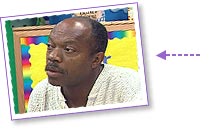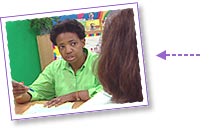Join us for conversations that inspire, recognize, and encourage innovation and best practices in the education profession.
Available on Apple Podcasts, Spotify, Google Podcasts, and more.
In the session, you will watch Dr. Paratore’s lecture on differentiating instruction for early literacy.
Print Dr. Paratore’s Differentiating Instruction Lecture Posters (PDF). Use the posters to take notes on the lecture.
In this video segment, Dr. Paratore reviews the research on grouping formats. These formats include ability grouping, whole-class instruction, and flexible grouping. Next, she presents classroom practices and routines that reflect the research and support flexible grouping for reading instruction. Use the video image below to locate where to begin viewing.
An accompanying lecture transcript (PDF) is also available.
Video Segment – Dr. Paratore’s Lecture
 Find this segment approximately 3 minutes and 35 seconds after the begining of the video. Watch for about 10 1/2 minutes.
Find this segment approximately 3 minutes and 35 seconds after the begining of the video. Watch for about 10 1/2 minutes.
After watching the lecture, review your notes and consider these questions:
Following the lecture, the workshop participants discuss their questions and concerns in providing differentiated instruction to address the needs of all children.
Video Segment – Questions and Challenges
 Find this segment approximately 13 minutes and 55 seconds after the begining of the video. Watch for about 3 minutes.
Find this segment approximately 13 minutes and 55 seconds after the begining of the video. Watch for about 3 minutes.
Now return to your Differentiating Instruction Chart. Add any new questions or challenges that have come from watching the video segment. Identify which teaching practices you have successfully implemented for grouping children in grades K-2.
In this section, you will relate Dr. Paratore’s lecture and your readings to teaching practices in classroom excerpts.
Now you will observe a reading lesson using a flexible grouping model to differentiate instruction. First-grade teacher Valerie Kostandos teaches a grade-level story using whole-class and small-group instruction to meet the needs of all of her students.
Video Segment – Flexible Grouping Classroom Excerpt
 Find this segment approximately 16 minutes and 55 seconds after the beginning of the video. Watch for about 7 1/2 minutes.
Find this segment approximately 16 minutes and 55 seconds after the beginning of the video. Watch for about 7 1/2 minutes.
After watching the classroom excerpt, consider these questions:
In this section, you will watch the workshop participants discuss the classroom excerpt.
After viewing the flexible grouping model, the workshop participants discuss the lesson. Compare your ideas with theirs.
Video Segment – Discussion
 Find this segment approximately 24 minutes and 35 seconds after the beginning of the video. Watch for about 11 1/2 minutes.
Find this segment approximately 24 minutes and 35 seconds after the beginning of the video. Watch for about 11 1/2 minutes.
Following the workshop participants’ discussion, consider these questions:
In this section, you will relate Dr. Paratore’s lecture and your readings to teaching practices in classroom excerpts.
Now you will observe differentiated instruction in which children are grouped by similar needs (homogeneous grouping). You will watch two guided reading lessons, one in first grade and one in a combined first and second grade. Then you will observe two independent first-grade readers as they research spiders with more challenging texts.
Video Segment – Homogeneous Grouping Classroom Excerpts
 Find this segment approximately 36 minutes and 10 seconds after the beginning of the video. Watch for about 9 minutes.
Find this segment approximately 36 minutes and 10 seconds after the beginning of the video. Watch for about 9 minutes.
After viewing the classroom excerpts, consider these questions:
In this section, you will watch the workshop participants discuss the classroom excerpts.
Following the homogeneous grouping models, the workshop participants discuss the lessons. Compare your ideas with theirs.
Video Segment – Further Discussion
 Find this segment approximately 44 minutes and 55 seconds after the beginning of the video. Watch for about 11 1/2 minutes.
Find this segment approximately 44 minutes and 55 seconds after the beginning of the video. Watch for about 11 1/2 minutes.
After watching the workshop participants’ discussion, consider these questions:
“Our responsibility is to advance the literacy of every child, even if that child comes to us already capable. Our responsibility is to stretch every child with whom we work.”
How do you advance the literacy development of your students with your instruction, grouping, and literacy routines?